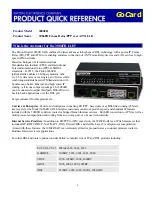
79
•
TE
class
—Defines a CT and a priority. The setup priority or holding priority of an MPLS TE
tunnel for a CT must be the same as the priority of the TE class.
The prestandard and IETF modes of DS-TE have the following differences:
•
The prestandard mode supports two CTs (CT 0 and CT 1), eight priorities, and a maximum of 16
TE classes. The IETF mode supports four CTs (CT 0 through CT 3), eight priorities, and a
maximum of eight TE classes.
•
The prestandard mode does not allow you to configure TE classes. The IETF mode allows for
TE class configuration.
•
The prestandard mode supports only RDM. The IETF mode supports both RDM and MAM.
•
A device operating in prestandard mode cannot communicate with devices from some vendors.
A device operating in IETF mode can communicate with devices from other vendors.
How DS-TE operates
A device takes the following steps to establish an MPLS TE tunnel for a CT:
1.
Determines the CT.
A device classifies traffic according to your configuration:
{
When configuring a dynamic MPLS TE tunnel, you can use the
mpls te bandwidth
command on the tunnel interface to specify a CT for the traffic to be forwarded by the tunnel.
{
When configuring a static MPLS TE tunnel, you can use the
bandwidth
keyword to specify
a CT for the traffic to be forwarded along the tunnel.
2.
Checks whether bandwidth is enough for the CT.
You can use the
mpls te max-reservable-bandwidth
command on an interface to configure
the bandwidth constraints of the interface. The device determines whether the bandwidth is
enough to establish an MPLS TE tunnel for the CT.
The relation between BCs and CTs varies by BC model.
{
In RDM model, a BC constrains the total bandwidth of multiple CTs, as shown in
−
BC 2 is for CT 2. The total bandwidth for CT 2 cannot exceed BC 2.
−
BC 1 is for CT 2 and CT 1. The total bandwidth for CT 2 and CT 1 cannot exceed BC 1.
−
BC 0 is for CT 2, CT 1, and CT 0. The total bandwidth for CT 2, CT 1, and CT 0 cannot
exceed BC 0. In this model, BC 0 equals the maximum reservable bandwidth of the link.
In cooperation with priority preemption, the RDM model can also implement bandwidth
isolation between CTs. RDM is suitable for networks where traffic is unstable and traffic
bursts might occur.
Figure 30 RDM bandwidth constraints model
{
In MAM model, a BC constrains the bandwidth for only one CT. This ensures bandwidth
isolation among CTs no matter whether preemption is used or not. Compared with RDM,
MAM is easier to configure. MAM is suitable for networks where traffic of each CT is stable
and no traffic bursts occur.
shows an example:
−
BC 0 is for CT 0. The bandwidth occupied by the traffic of CT 0 cannot exceed BC 0.
−
BC 1 is for CT 1. The bandwidth occupied by the traffic of CT 1 cannot exceed BC 1.
−
BC 2 is for CT 2. The bandwidth occupied by the traffic of CT 2 cannot exceed BC 2.
Содержание HPE FlexNetwork MSR Router Series
Страница 10: ...viii Index 540 ...















































